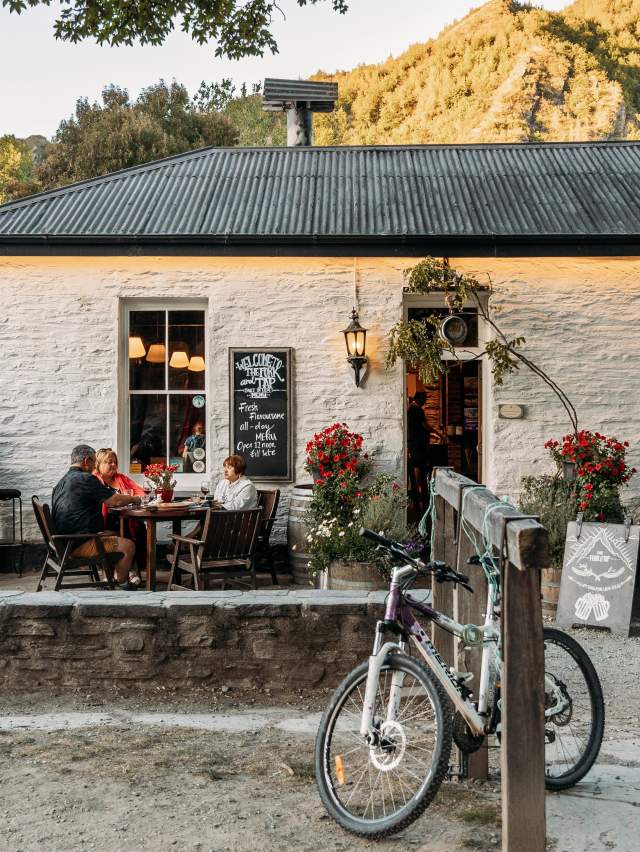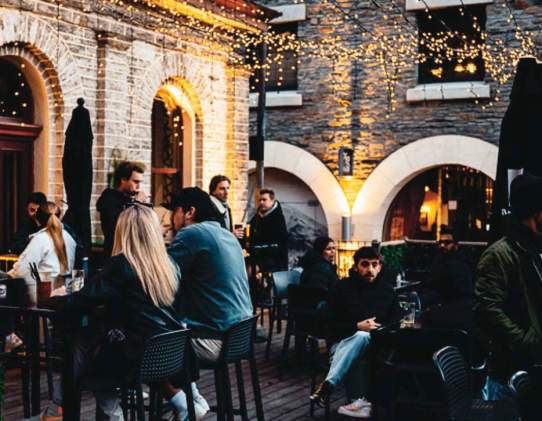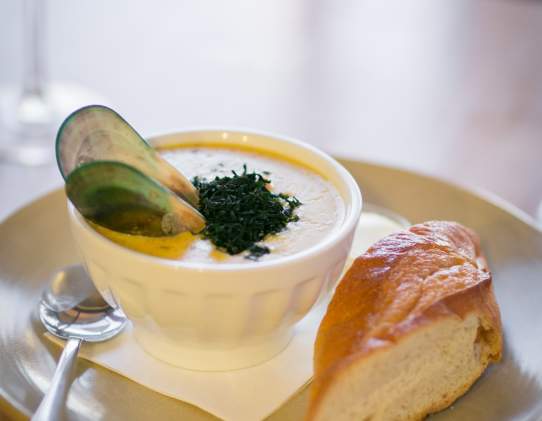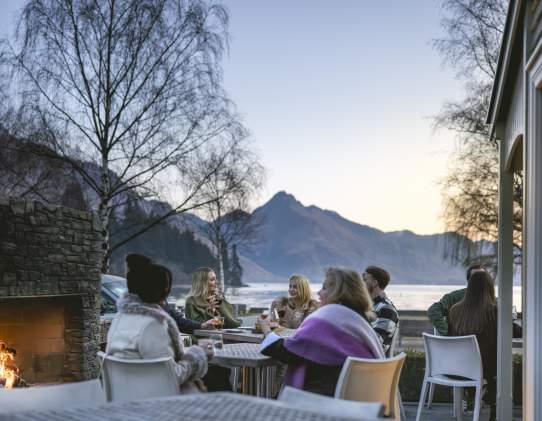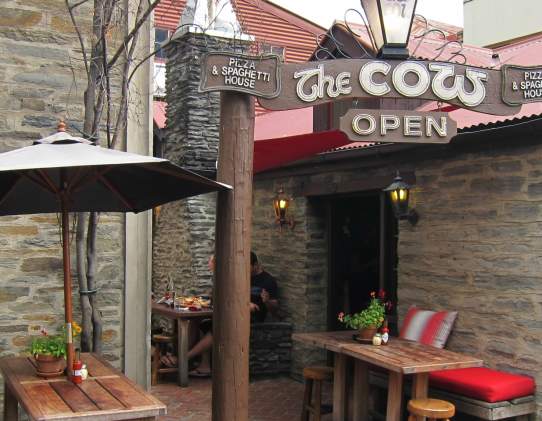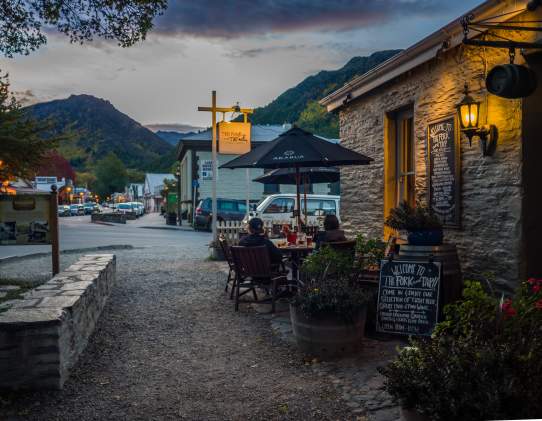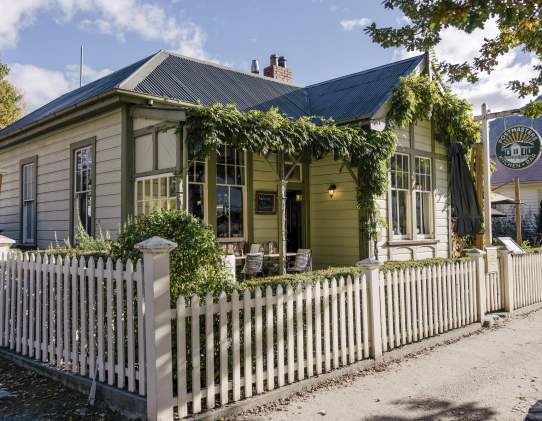If you love food, chances are you enjoy the stories behind your food, including the way historic eateries preserve and highlight local heritage. Queenstown’s historic hotels and restaurants offer traditional and contemporary cuisine in storied settings, making them an unmissable part of the unique food experience you’ll find in Queenstown.
Queenstown’s Rich Culinary History
Māori people began travelling to Lake Whakatipu on seasonal hunting expeditions around 800 years ago. The area was rich in mahinga kai, Māori customary food gathering sites. People hunted the region’s eels and birds, and gathered plants such as aruhe, the underground rhizomes of bracken, cabbage tree stems, and seasonal greens. When Māori settled more permanently in the area – Queenstown Gardens is the site of a Māori pā – they would have planted the kūmara, yams, and taro they introduced to New Zealand.
In the late 1850s, the first European colonisers began to arrive in the region. William Rees was one of the first settlers to establish a farm, with a flock of sheep and a boat to bring supplies from the south end of the lake. Food would have been basic, and the region would have continued to be a remote rural backwater, were it not for the 1860s gold rush. In the first weeks of the rush, Rees was the only source of food for miners working around Lake Whakatipu. But where gold appears, commerce follows. By early 1864 there were 18,000 miners in the region, and seventeen hotels, along with a throng of temporary provision shops and bakeries, had sprung up to feed and water the crowd. Chinese goldminers in Arrowtown planted vegetables and sold their extras, supplying fresh veg to the goldfields.
One early (but not very delicious) Queenstown food story is about a German immigrant known as Charlie the Baker, who became tired of catering for a guest with a huge appetite. One evening, his visitor complimented Charlie on his tasty stew and Charlie told him it was all due to the lovely, fat, juicy rat he’d caught that morning. The guest left the next day.
The first vineyard in Queenstown was planted in 1864 by miner John Desire Feraud. He established Monte Cristo winery near Clyde, earning praise here and in Australia for his efforts. Queenstown then had to wait until the 1980s for local visionaries to pioneer our modern wine industry and provide Queenstown with its own distinctive wine.
For over 100 years, most New Zealand immigrants were from the UK, so plain British food was common. You’d be served the classic Kiwi roast meat, and three veg. Queenstown’s isolated location meant people had to be self-sufficient, and many locals would have been good at growing a few veggies, brewing, preserving, and baking.
Until 1981 Queenstown's population was less than 3,500. Today 29,000 people live here. In the last forty years people have moved here from Europe, Asia, Africa, the Pacific, the Middle East, and South America. Each group brought their own regional culinary traditions, and now Queenstown’s restaurant scene is an international melting pot, with everything from a Brazilian patisserie to street food from Asia, and Polynesian fusion food.
Taste the History at these Storied Queenstown Eateries
Eichardt’s Bar
This historic hotel is on the site of William Rees’s woolshed, the first building built by pakeha settlers in Queenstown. In 1862, gold was discovered nearby, and Rees quickly converted the woolshed into a hotel called the Queen’s Arms. In 1866, Rees entered into partnership with Albert Eichardt, who bought the hotel and changed the name. In 1868, Albert married Julia Shanahan, the hotel dining room manager. Julia was the real force behind Eichardt’s – steering it through the transition from miners’ bar to a tourist hotel. She was formidable and well respected, keeping firm control of the bar, sending drunks out the back to cool down to a little room known as the stone jug.
Today, Eichardt’s Bar is still rich in ambience, if a little less rowdy. Leather sofas sit beside the fire, and you can settle in and order a bowl of their renowned seafood chowder from their tapas menu, which is rich in local flavours, wild thyme from Gibbston, walnuts from Lake Hayes, mushrooms from Moke Lake, and sourdough made with wild Whakatipu yeast. Sip on a glass of local Pinot from their impressive wine list and contemplate the “cavalcade of colourful characters who congregated at Eichardt’s in the past.
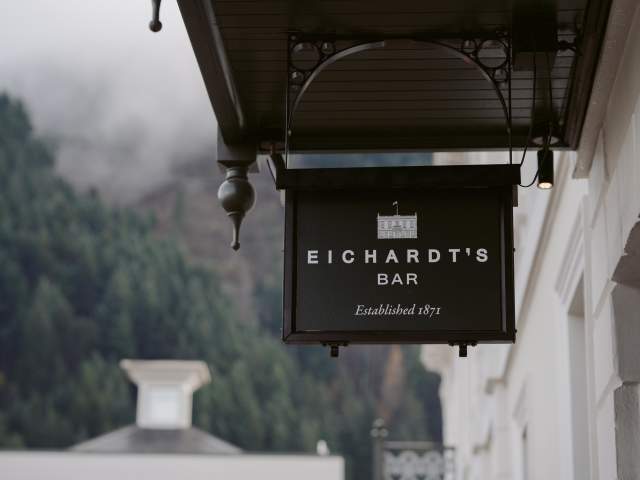
Speight’s Ale House
The Speight’s Ale House building began its life as the Queenstown Council Chambers. The building was designed in 1880 by noted Invercargill architect F.W. Burwell, who designed a schist building with Romanesque details to complement his earlier designs for the stone courthouse and library buildings opposite. The Chambers opened in 1881.
In 2000 the building was converted into the Speights Ale House, with an atmospheric historic interior and original features such as the private dining room in the public record vaults. In 2023 a fire severely damaged the building. However the owners embarked on a painstaking reconstruction with the support of Heritage New Zealand, and the Ale House recently reopened with the interiors looking the same as they did before the blaze.
Sample brews on tap from Speight’s brewery based down the road in Dunedin, who’ve been brewing ales with local ingredients since 1876. The menu is hearty Kiwi pub grub, with locally sourced lamb, beef, and fresh market fish.
1876 Queenstown
Set in Queenstown’s former magistrates court, the courthouse opened in 1876, one of a cluster of municipal buildings built to bring civic order to the unruly goldmining town. Before its construction, the wardens serving Queenstown and Arrowtown operated out of tents. Also designed by F.W. Burwell, the courthouse was built from local schist with a corrugated iron roof. It was used as a courthouse until 2006, when a new justice precinct was built.
The building was then transformed into a bar and restaurant celebrating its rich history. 1876 Queenstown complements its characterful interior with a large sunny deck, regular live music and DJs as entertainment, and excellent deals on food and beer.
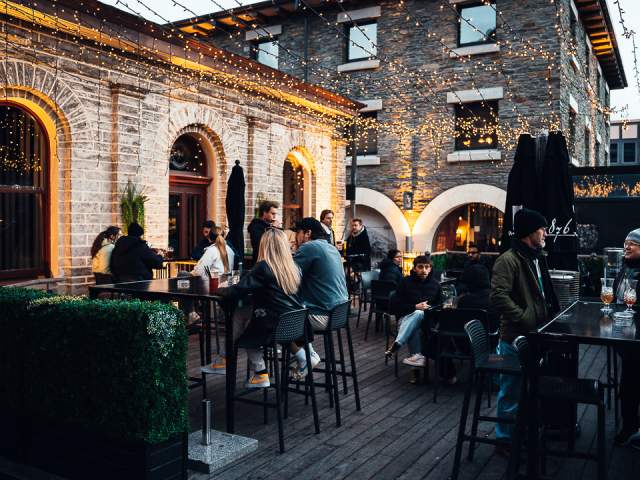
The Bathhouse Café & Restaurant
This classic Edwardian-style bathhouse was built for bathers in 1911. People changed in changing stalls, before wading into the lake from the sandy shore, or diving from one of the diving platforms. Called the Coronation Bathhouse, it was built to celebrate the coronation of King George V. Look out for the red central crown that marks the event.
In the 1940s the bathhouse fell out of favour and the building was used as a summer teahouse by students and the Whakatipu Rowing Club. It became increasingly dilapidated, and the Department of Conservation and the Historic Places Trust carried out restoration in 1987 . In 1993 an architect leased the building, then in 1996 local restaurateur Guy Evatt returned the Bathhouse to a teahouse. It has been an eatery ever since.
Today, the Bathhouse is run by chefs Ben Bayly and Steven Sepsy – the team behind Aosta and Little Aosta in Arrowtown. They celebrate the building’s British origins with colonial classics such as coronation chicken, scotch egg, and trifle, made with exceptional New Zealand produce and a contemporary foodie lens.
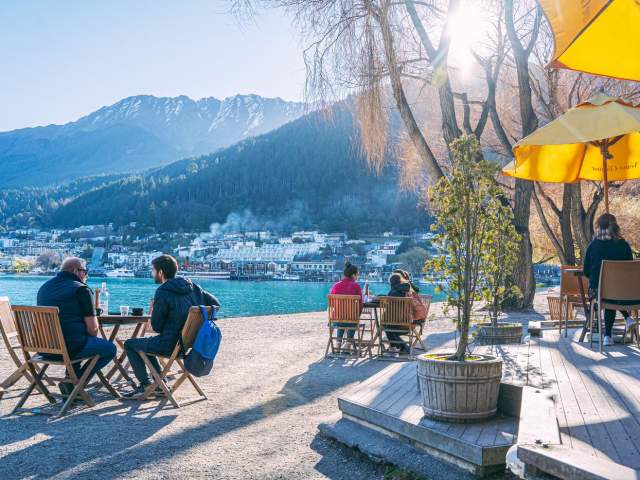
Botswana Butchery
This popular local bistro is set in historic Archer's Cottage. It is part of the Marine Parade Heritage Precinct, a group of buildings built from the1860s onwards, that represent a time capsule of Queenstown village life in the Victorian and Edwardian eras.
The building was converted into Botswana Butchery in 2008, and fast became a firm favourite for Queenstowners and visitors alike, winning a Cuisine Good Food Guide award. Inside is snug and intimate with wood panelling, roaring fires, comfortable seating, and top-notch service. The menu is hearty and sophisticated, with bistro classics, cuts of well-aged meat, and international influences, while the wine list draws from an impressive cellar.
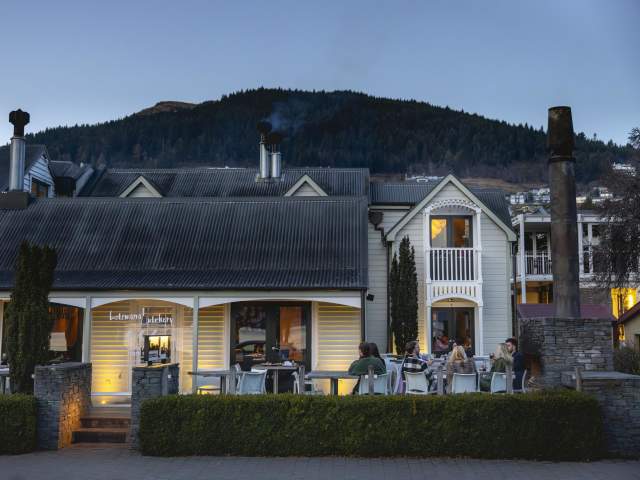
The Cow – Pizza & Spaghetti House
A local icon, the Cow has been serving up Italian food to Queenstowners since 1977. Set in a converted stone milking barn in Cow Lane, the restaurant takes its name both from the cows that would wander down the lane for daily milking and from an unflattering nickname given to Queen Victoria, who likened breast-feeding her nine children to being a cow. This is why there are so many pictures of the Queen, Prince Albert, and the royal family in the Cow.
This classic 70s take on a trattoria was an instant hit. In the 80s and 90s the Cow became quite the après ski party spot. There was even a Cow ski team. Today the Cow serves up Italian family favourites, and a pizza menu unchanged since 1977 – check out Portofino for a winning blast from the past and don’t miss Her Majesty’s Pleasure for a right royal tasty bite.
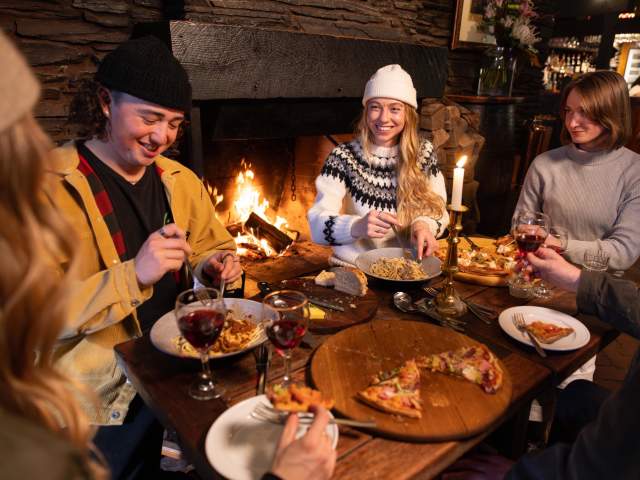
Gantley’s Tavern
This historic stone building is one of Queenstown's oldest hospitality businesses, built in 1865 to provide food, drink, and lodging in the gold rush. Gantley’s Tavern is named after Patrick Gantley, who came to New Zealand that same year as the Queenstown jailer. When he retired from the police force, he bought the Pack Horse Hotel at Arthurs Point, refurbished and reopened it with his wife in 1874, changing the name to the Sportsman's Arms.
After Patrick and his wife died, their son Francis Gantley took over the pub and named it Gantley's, but he stopped trading in 1920. For many years, the property was run as a farm, and hay was stored in the old pub. In 1970 it was restored as a restaurant called the Packer's Arms. In 1993, new owners changed the name back to Gantley's and ran a fine dining restaurant, then in 2019, the Cargo Collective brewing company took over and named it Cargo at Gantley’s. In 2023, Cargo moved to a new purpose-built brew hall out the back of the old tavern and Euan Paterson took over custodianship of Gantley’s Tavern.
The menu has dishes the goldminers might have recognised, honest pub grub like Otago lamb shoulder, sausage and mash, and a chicken, bacon, and mushroom pie. You can carry your Cargo Collective Old English Ale out to the large grassy beer garden where Patrick Gantley once played quoits and imagine you’re back in the gold rush days.
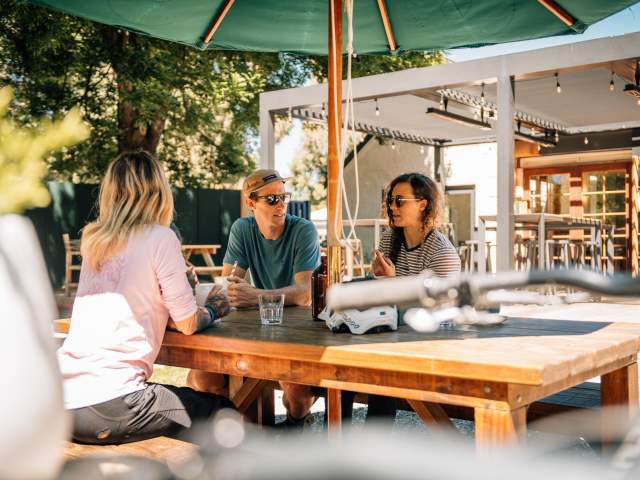
The Fork and Tap
Situated in the historic precinct on Buckingham Street in Arrowtown, the Fork and Tap building was built as a private home out of local stone with a limewash render in 1874. In 1875 it became the Colonial Bank of New Zealand in Arrowtown, then the offices of the Lake Country Press newspaper, before returning to residential use from 1896 until the 1970s, when it was converted into tearooms. The building was recently renovated and strengthened reusing the original materials, and handmaking other fittings to match the historic style.
The Fork and Tap opened in the 150-year-old stone building in 2011. Owners Jeannie and Keith serve up a simple, well-considered menu with produce sourced locally, including Southland beef and fish, Cardrona lamb, pork from Havoc, and greens from Tony up the road. They’ve 19 New Zealand craft beers on tap, including local drops.

Postmaster Kitchen & Bar
This heritage protected villa was constructed in 1907 to replace the original 1873 Postmaster’s cottage when it burnt down in 1906. The front room of the house was used as the Arrowtown post office until a dedicated building was opened in 1882. The villa continued to house post office staff until the 1980s, becoming a B&B, then an artist's residence, before its current incarnation as a restaurant.
Sam Laycock and Maria Kealy took over the business in 2013. They’ve combined the cottage's old-world charm with Central Otago food, wine, and hospitality to create a welcoming gastropub. The Postmaster Kitchen and Bar is all about great local produce, done simply and well. Pull up a chair on the veranda under the wisteria and raise a glass of fine local Pinot to the ghosts of Arrowtown past.
A.M. Miller, Queenstown District Historical Society President, 1975.

